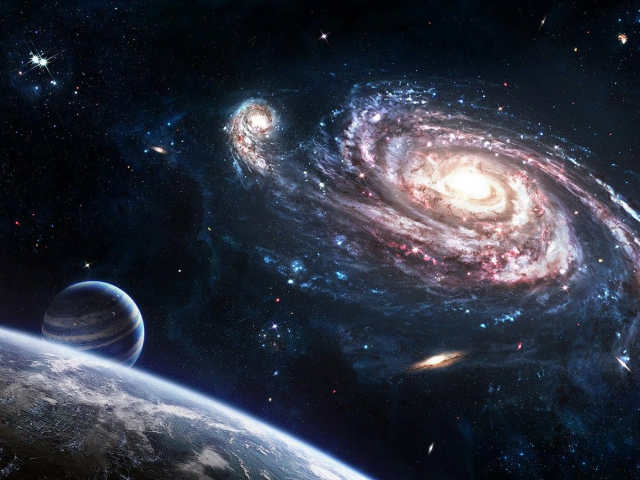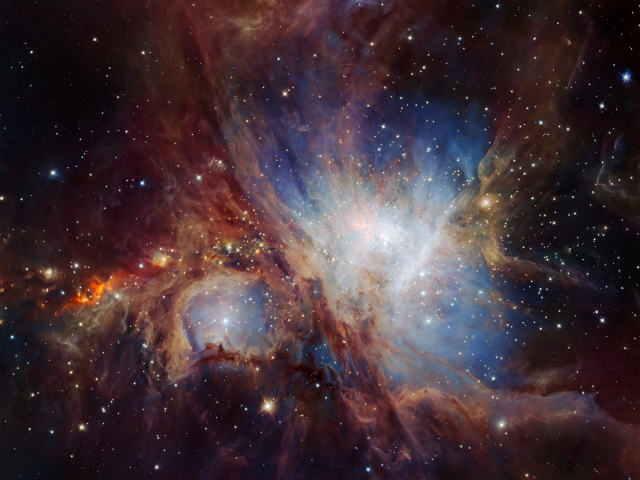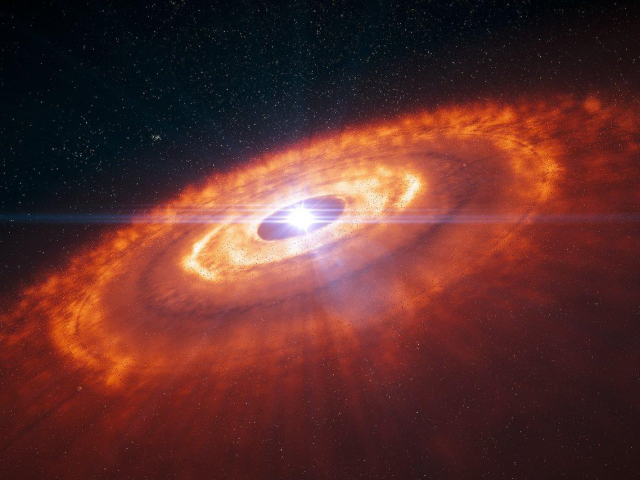
Galaxy Mergers
Galaxy mergers are a fairly common phenomenon in cosmology. It occurs when two galaxies pass through one another and do not collide. The merger triggers the intense formation of new stars and increases gravitational chaos. Previously, scientists had speculated that disk galaxies could form during the merger. Thanks to the powerful radio telescope ALMA, this theory was confirmed: after the merger of 24 celestial objects, the disk galaxies were formed.

Planet-Forming Lifeline
In a multi-stellar system called GG Tau-A, a gas-dust stream resembling a wheel within a wheel was detected in the constellation Taurus. It consists of two relatively independent disks. The scientists focused their attention on gas accumulations in the area between the disks. They assume that one serves as a lifeline for the other. The outer disk gives its resources to the inner one so that a new planet will be able to generate from it after some time. Such lifelines exist in many star systems, experts summarize.

Space Bubble
A glowing hot gas bubble stretching more than 55 thousand light years from Earth was discovered in 2009. It was named Himiko after the Queen of Japan. According to scientists, Himiko consists of three star clusters, each of them is a luminous galaxy. In these clusters, the time of star formation reaches an astonishing speed of about 100 solar masses per year. Astronomers believe that Himiko's interstellar gas is composed of hydrogen and helium. They also suggest that our galaxy could look similar to this bubble after the Big Bang.

Cosmic Dust
Cosmic dust is a crucial element in the formation of stars and planets. Scientists are certain that the universe is filled with it. The lion's share of dust is formed when the celestial bodies become extinct turning into supernovae. With the help of ALMA, scientists examined the remains of the supernova 1987A and found a great deal of cosmic dust inside it. Supernovae exploded in 1987, 168 thousand light years from Earth. According to experts, the young galaxies have more dust than the other celestial bodies. Therefore, cosmic dust plays an important role in the evolution of new galaxies, experts stress.

O-Stars
There are cosmic bodies akin to killers that hide in the Orion Nebula-the nursery of infant star. They are called O-type celestial bodies. Their mass is far bigger than the Sun and the temperature reaches 50 thousand degrees, Kelvin. O-stars control the birth and extinction of planetary systems in the outer space. During their existence, O-stars can destroy protoplanetary disks if embryo solar systems are close to them. Quite often young celestial bodies fall victim to O-stars due to the strongest electromagnetic radiation of the latter.

Event Horizon Telescope
In 2014, an ultra-precise atomic clock was installed at ALMA's Array Operations Site control panel to synchronize with a worldwide network of radio telescopes. That device was called the Event Horizon Telescope (EHT). According to scientists, it has an advanced zooming power that can help immensely in the study of black holes. The event horizon is the boundary defining the region of space around a black hole. Nothing, even the light, can escape its force of gravity. Scientists hope that the EHT will help them to confirm or deny the existence of the event horizon.

Birth Of Solar System
The first picture of planets forming in the protoplanetary disk around the young star HL Tau was taken by ALMA. It is 450 light-years from Earth in the constellation Taurus. So, scientists have had an opportunity to witness a rare phenomenon - the birth of a new solar system. They believe that our Solar System could have formed likewise. In the picture, HL Tau hides behind a giant gas-dust cloud. The star is surrounded by 8 concentric rings passing through the protoplanetary disk. This indicates the birth of eight new planets, scientists say.
 বাংলা
বাংলা 
 Русский
Русский English
English Bahasa Indonesia
Bahasa Indonesia Bahasa Malay
Bahasa Malay ไทย
ไทย Español
Español Deutsch
Deutsch Български
Български Français
Français Tiếng Việt
Tiếng Việt 中文
中文 हिन्दी
हिन्दी Čeština
Čeština Українська
Українська Română
Română
